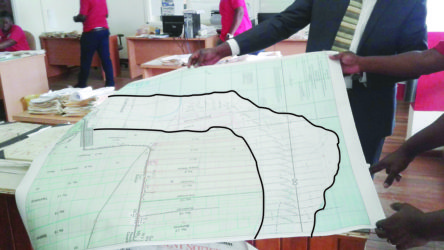Six persons are claiming lands north of Crab Island, Berbice, where a major oil support facility is to be built but the Guyana Lands and Surveys Commission (GL&SC) says that the swathes in question belong to the state.
The six had raised objections after the GL&SC had invited tenders for the development of the land surrounding the planned oil facility. The six argue that the land belonged to them and they have transports dating back to 1925. An advertisement placed by the group in yesterday’s Stabroek News said, “All lands situate within Lots 1-37 Right Bank of Berbice River; below Crab Island, East Coast Berbice, Kintyre/ Borlam are privately owned. No State Lands exist between the Original Sea Defence Dam and the foreshore of the North Atlantic”.

However, the GL&SC says that the six persons are indeed owners of some transported lands in the area, but that the swathes north of the sea defence belongs to the state as fixed by the law.
As such, the GL&SC is calling on the persons claiming ownership of the lands north of the the sea defence boundary to familiarise themselves with the law and not rush to make spurious public claims of ownership.
‘Inaccurate and misleading’
Following an article in the Stabroek News on March 26th, 2017 that the GL&SC was seeking serious interest for lands surrounding the planned Crab Island onshore facility, Elizabeth Samaroo, Hardat Singh, and Colin Elcock disputed that the lands belong to state and registered their complaints.
Through their attorney, Rexford Jackson, of the law firm Hanoman, Jackson and Associates, the group wrote to President David Granger seeking his intervention and a review of the matter so that the lands they said were in dispute are not sold or leased.
“This sketch plan, that is purported to be reflective or derived from the GLSC stock sheet No.s Zero to thirteen

(0-13), is inaccurate and misleading and requires immediate attention and to halt the spread of false information. Most of these tracts, labeled as State Land, actually belong to private proprietors. This essential material fact is being concealed from the public,” another of the six, Patricia Samaroo, wrote to President Granger.
She said that for example, an area labeled as ‘Plantation Lot No.7’ by GL&SC was defined on Plan No. 2198 by a Sworn Land Surveyor since July 1925 and deposited in the Deeds Registry at New Amsterdam in Berbice, on 30th March, 1926.
Samaroo contended that except for Crab Island, and the adjoining lands, the State has no land north of the Sea Defence Dam at Plantations Lots 1-37 on the West Coast of Berbice. “All lands in this area are bounded on the north by the Atlantic Ocean and what is perhaps the largest coastal swamp in Guyana. It is propagated with courida and mangroves, which help to protect us from the fury of the Atlantic Ocean …This swamp is also a sanctuary for birds and serves as a spawning ground and natural habitat for several species of seafood which help to feed this nation. Gone will be the days of the buck crab and the Corentyne black shrimp, which is so desirable. Several correspondence from previous administrations dating back to the British validates undisputed, exclusive ownership of these lands,” she added.
The Number 7 Village, East Coast Berbice resident appealed to the President to “act swiftly and to stop any impending sale” of privately owned lands. One week later, the president replied and informed Samaroo that he had forwarded her letter to Commissioner of Lands and Surveys Trevor Benn, who he said would examine her complaints and respond to her.
‘This is the law’
Yesterday, Benn called in his agency’s Legal Advisor and Manager of Surveys to explain to Stabroek News why the lands being claimed by Samaroo and others are not private but state lands. “This is the law, because all of the lands from the current sea defence to the sea, the Atlantic Ocean…are state lands. Their transported lands are at the back of it. Their transported lands would stop at the sea defence or sea defence reserve,” the legal advisor, Yolanda Lammot, noted.
Survey Manager Rene Duesbury pointed to the Kitty area as an example, saying that decades ago, also, lands were allotted all the way out to the Atlantic Ocean, where the current Kitty Public Road was then called George Street. He said that when the line of defence at Kitty was drawn up, all areas after the line became state lands, what is now known as the Kitty foreshore.
Benn told Stabroek News that while some persons will see the areas designated for proposed leases and development as “just a swamp,” investors who would have submitted proposals yesterday know the potential of the area and will invest.
He also promised that his agency will soon give an update on the proposals it received. Yesterday was the closing date for calls by GL&SC for developers for state lands.
In advertisements in recent weeks, the GL&SC invited offers for the purchase of leasehold interest for a term of 50 years for 22 tracts, numbered one to 22, on the right bank of the Berbice River, just below Crab Island.
Benn had told this newspaper that rather than lease the lands on an application basis, which would entail a longer process, the agency chose to advertise so that individuals or local and foreign companies can bid and submit proposals for development.
“There is a heavy interest in the area and we want to have a more structured way in allocating the land to persons who can occupy, rather than receiving individual applications,” Benn explained.
He said that a public advertisement sells the idea to more persons and a non-refundable $300,000 project review fee could see serious bidders as opposed to those buying and holding for future market purposes.
The GL&SC advertisement stated that persons could have obtained, from its Hadfield Street office, a copy of the sketch plan showing the acreage of each tract and GL&SC standard proposal guidelines, for a $10,000 fee.
In late December, 2016, Minister of Natural Resources, Raphael Trotman announced that government plans to invest in an onshore oil and gas facility at Crab Island, which, when completed, will see the investment of US$500 million and the creation of 600 jobs.








